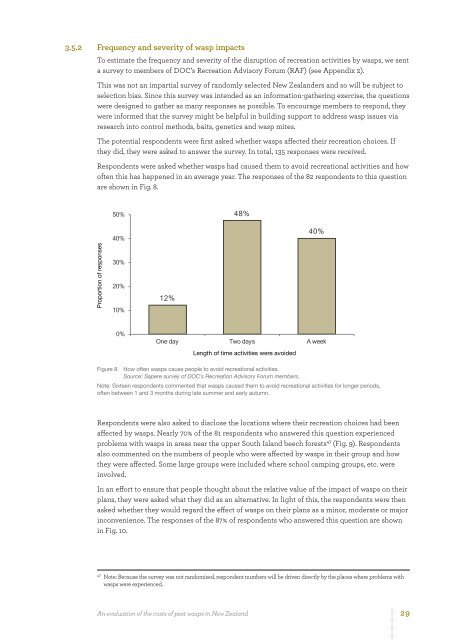evaluation-pest-wasps-nz
evaluation-pest-wasps-nz
evaluation-pest-wasps-nz
You also want an ePaper? Increase the reach of your titles
YUMPU automatically turns print PDFs into web optimized ePapers that Google loves.
3.5.2 Frequency and severity of wasp impactsTo estimate the frequency and severity of the disruption of recreation activities by <strong>wasps</strong>, we senta survey to members of DOC’s Recreation Advisory Forum (RAF) (see Appendix 2).This was not an impartial survey of randomly selected New Zealanders and so will be subject toselection bias. Since this survey was intended as an information-gathering exercise, the questionswere designed to gather as many responses as possible. To encourage members to respond, theywere informed that the survey might be helpful in building support to address wasp issues viaresearch into control methods, baits, genetics and wasp mites.The potential respondents were first asked whether <strong>wasps</strong> affected their recreation choices. Ifthey did, they were asked to answer the survey. In total, 135 responses were received.Respondents were asked whether <strong>wasps</strong> had caused them to avoid recreational activities and howoften this has happened in an average year. The responses of the 82 respondents to this questionare shown in Fig. 8.How often has this happened in an average year?50%48%Proportion of responses40%30%20%10%12%40%0%One day Two days A weekLength of time activities were avoidedFigure 8. How often <strong>wasps</strong> cause people to avoid recreational activities.Source: Sapere survey of DOC’s Recreation Advisory Forum members.Note: Sixteen respondents commented that <strong>wasps</strong> caused them to avoid recreational activities for longer periods,often between 1 and 3 months during late summer and early autumn.Respondents were also asked to disclose the locations where their recreation choices had beenaffected by <strong>wasps</strong>. Nearly 70% of the 81 respondents who answered this question experiencedproblems with <strong>wasps</strong> in areas near the upper South Island beech forests 47 (Fig. 9). Respondentsalso commented on the numbers of people who were affected by <strong>wasps</strong> in their group and howthey were affected. Some large groups were included where school camping groups, etc. wereinvolved.In an effort to ensure that people thought about the relative value of the impact of <strong>wasps</strong> on theirplans, they were asked what they did as an alternative. In light of this, the respondents were thenasked whether they would regard the effect of <strong>wasps</strong> on their plans as a minor, moderate or majorinconvenience. The responses of the 87% of respondents who answered this question are shownin Fig. 10.47Note: Because the survey was not randomised, respondent numbers will be driven directly by the places where problems with<strong>wasps</strong> were experienced.An <strong>evaluation</strong> of the costs of <strong>pest</strong> <strong>wasps</strong> in New Zealand29


